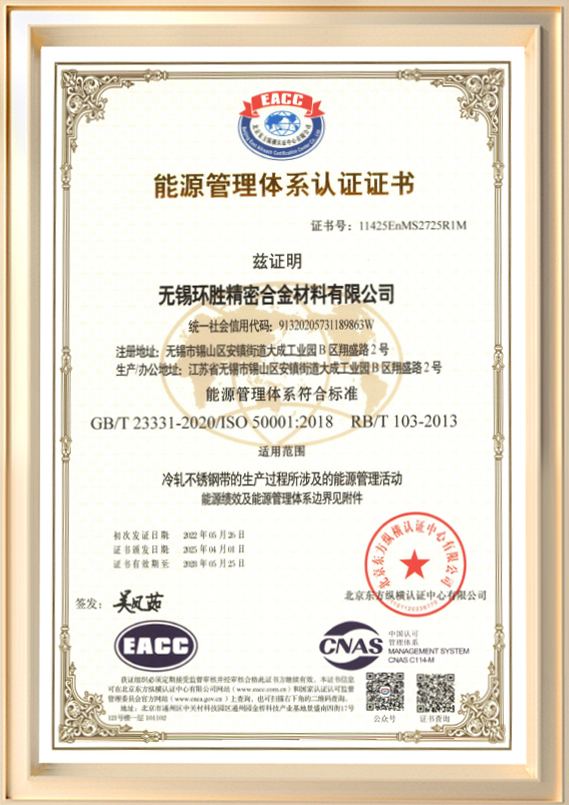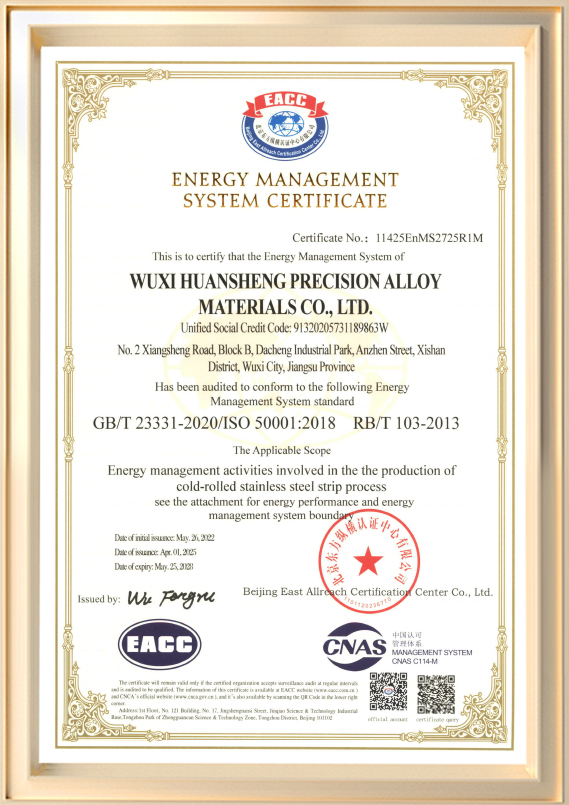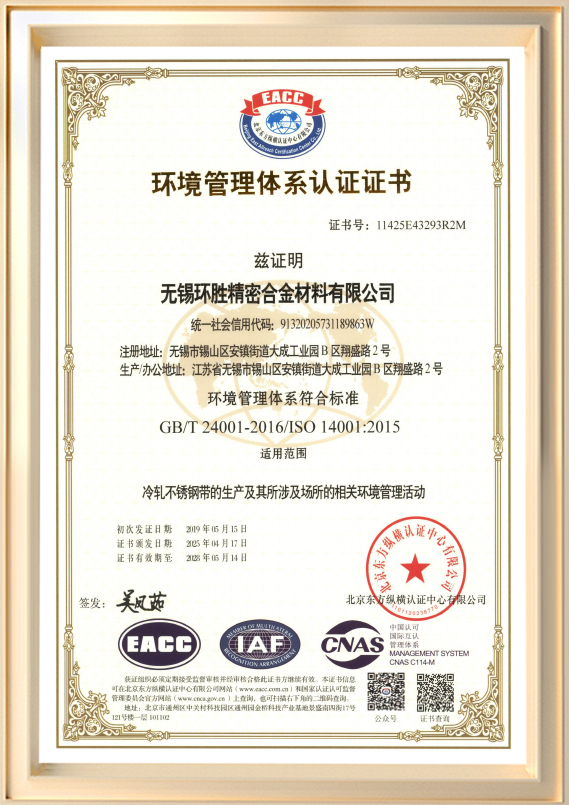What Makes WuXi Huansheng’s BA Finish Stainless Steel Strips and 3/4H Stainless Steel Coils Stand Out in the Industry?
WuXi Huansheng Precision Alloy Materials Co., Ltd., founded in 2001 and formerly known as Wuxi Huansheng Metal Products Co., Ltd., has established itself as a leading manufacturer specializing in cold-rolled stainless steel products. With a registered capital of 60 million RMB and a sprawling plant area of approximately 45,990 square meters, the company boasts an impressive annual production capacity of 72,000 tons. Its ability to produce stainless steel strips with thicknesses ranging from 0.03 mm to 3.0 mm and widths up to 550 mm positions it as a trusted supplier for a wide range of industries worldwide. Among its flagship products are the BA (Bright Annealed) finish stainless steel strips and the 3/4H stainless steel coils, which have garnered recognition for their quality, versatility, and performance.
BA Finish Stainless Steel Strips: Features and Advantages
BA finish stainless steel strips from WuXi Huansheng are characterized by their smooth, reflective surface and exceptional flatness. The bright annealing process, performed in a controlled hydrogen atmosphere, ensures a uniform surface finish with minimal scale, making these strips visually appealing and functionally reliable. The high level of surface smoothness not only enhances aesthetic appeal but also reduces the need for post-processing treatments in applications that require a pristine look.
One of the key advantages of BA finish strips is their superior corrosion resistance. WuXi Huansheng utilizes high-quality stainless steel grades, ensuring that these strips perform exceptionally well in challenging environments. The strips exhibit excellent resistance to oxidation, acid corrosion, and other chemical exposures, which makes them ideal for use in both industrial and decorative applications.
In addition, BA finish stainless steel strips maintain excellent mechanical properties. The precise cold-rolling process ensures uniform thickness and consistent hardness throughout the strip, providing reliable performance in demanding applications. Their high dimensional accuracy and flatness contribute to reduced material waste and facilitate easier fabrication.
Applications of BA Finish Stainless Steel Strips
The versatility of BA finish stainless steel strips allows them to be used across a variety of industries. In architecture and interior design, they are often used for decorative panels, elevator interiors, ceiling panels, and handrails, where aesthetic quality is paramount. The smooth reflective surface of the BA finish adds a modern and professional look to these applications.
In the manufacturing sector, BA finish strips are utilized in precision machinery, automotive components, and electronic enclosures. Their consistent thickness and high surface quality ensure tight tolerances and reliable performance. Furthermore, their corrosion-resistant properties make them suitable for kitchen appliances, medical equipment, and chemical processing equipment, where both hygiene and durability are critical considerations.
3/4H Stainless Steel Coils: Features and Advantages
The 3/4H stainless steel coils produced by WuXi Huansheng offer a balanced combination of hardness and ductility. The 3/4H designation refers to a hardness level achieved through work hardening, which makes the material moderately hard while still retaining sufficient flexibility for forming and bending operations. This intermediate hardness level makes the coils ideal for applications that require both strength and moderate formability.
One of the most notable advantages of 3/4H stainless steel coils is their excellent dimensional stability. WuXi Huansheng’s advanced cold-rolling technology ensures uniform thickness and width throughout the coil, minimizing distortion during processing. Additionally, the high-quality alloy composition provides outstanding corrosion resistance, making the coils suitable for environments with varying humidity and exposure to chemicals.
The 3/4H coils also exhibit superior surface quality. The cold-rolling process, combined with stringent quality control, results in coils with minimal surface defects, ensuring they are ready for use in precision applications. Their smooth surface facilitates easier fabrication, welding, and finishing, which reduces production time and costs for downstream manufacturers.
Applications of 3/4H Stainless Steel Coils
3/4H stainless steel coils are widely applied in sectors that demand strength, durability, and moderate formability. In the construction industry, they are commonly used for structural components, roofing, cladding, and curtain walls, where the combination of mechanical strength and aesthetic appeal is essential.
In the transportation sector, 3/4H coils are used in automotive frames, chassis components, and rail equipment, where reliability under mechanical stress is critical. Their corrosion resistance ensures longevity even in harsh weather conditions or exposure to road salts.
The electrical and electronics industries also benefit from 3/4H coils, particularly in the manufacturing of enclosures, brackets, and precision components that require dimensional accuracy and surface quality. Moreover, the food processing and chemical industries rely on 3/4H stainless steel coils for tanks, pipelines, and equipment that must resist corrosion while handling moderate mechanical loads.
Why Choose WuXi Huansheng Precision Alloy Materials Co., Ltd.?
WuXi Huansheng’s extensive experience in the production of cold-rolled stainless steel products has allowed it to develop robust expertise in quality control, alloy composition, and surface finishing. The company combines state-of-the-art production technology with strict quality management systems to ensure that each BA finish strip and 3/4H stainless steel coil meets international standards.
Moreover, WuXi Huansheng’s capacity to produce a wide range of thicknesses and widths provides flexibility to meet customer-specific requirements. The company’s commitment to research and development ensures continuous improvement of product quality, performance, and application solutions, allowing clients across diverse industries to access high-performance stainless steel materials tailored to their needs.
Conclusion
WuXi Huansheng Precision Alloy Materials Co., Ltd. stands out in the stainless steel industry due to its high-quality BA finish stainless steel strips and 3/4H stainless steel coils. The BA finish strips offer exceptional surface smoothness, corrosion resistance, and aesthetic appeal, making them ideal for decorative, architectural, and precision engineering applications. Meanwhile, 3/4H stainless steel coils provide a perfect balance of hardness and ductility, combined with excellent dimensional stability and corrosion resistance, making them suitable for structural, automotive, industrial, and food processing applications.
By prioritizing quality, innovation, and customer satisfaction, WuXi Huansheng continues to provide stainless steel products that meet the highest industry standards and support the growing demands of global markets. With a strong focus on reliability and performance, the company remains a preferred partner for businesses seeking premium cold-rolled stainless steel solutions.


 English
English русский
русский













